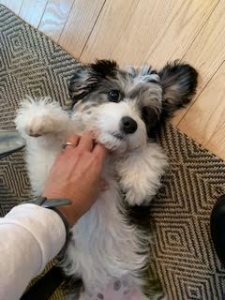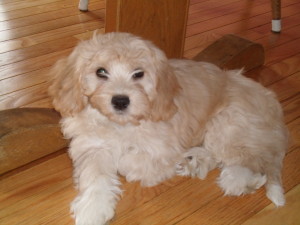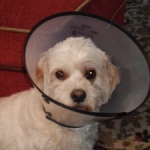It is the time of the year when many of you have, or will be, welcoming new puppies into your homes and lives. I think that I am most often approached by people I know with questions about specific issues they are having with their puppy. Even if you have had dogs for years, each puppy seems to present new issues. That is because they all have different personalities and abilities to learn, and different motivations to do so. Also, depending on how many people are in the household, and how many of them are young children, the situation can get complicated.
So I thought I would have a few posts with some general puppy training recommendations that I hope will be helpful. Your level of experience will dictate how useful you find these posts. These are guidelines which I espouse, but may not be agreed upon by all veterinarians, trainers or pet parents. Still, they are techniques time tested by so many people that I trust, that I recommend them to clients, and use them in my own home. I will list good training books as well.
Breed/puppy choice: It is best if you have researched a breed, the breeders, the puppy’s parents and puppy itself prior to adoption. Each breed has inherent mannerisms, and levels of energy and needs. Often though, this has not happened, and you may be adopting a mixed breed, or a rescued pup or dog from a pet store. Regardless, the goal is to achieve a socialized, well-mannered puppy. The sooner your pup is taught correct behavior and manners, the easier it will be. Remember, they are always learning, be it good or bad behavior. If training is left till later, or for only a single member of a household, bad behaviors may be reinforced and become habit. Early, gentle training helps prevent bad habits. The smaller a pup, the easier it is to physically control and guide him/her.
Crate training: If you can keep your eyes on your puppy 24 hours a day, 60 minutes an hour until he or she is 3-5 years old, you do not need a crate. But, since most of us need to sleep, shower, work, etc., most of us need a crate for our puppy. It is a safe place, is the first step to housebreaking, and protects your pup from injury or accident, and establishes your role as leader. Crate trained puppies also stress less when the time comes for travel or hospitalization.
Puppies in crates are always good. By that I mean, once in their crates, they have done a good thing for us, and should only be given encouraging words. It should be a “Happy Place ” for them. Their activities are limited in crates. It is their special place, their bedroom. They may be noisy for a while, but they will, I assure you, adjust to it if used properly. They will not harm your belongings or themselves there. They cannot chew on wires or toxic substances while in there. One tip, do not keep their collar on while in the crate. It can get caught on metal prongs and choke them.
 I prefer that very new pups have a crate from the day you bring them home. It should be kept open in the beginning, with it being partitioned off to only fit the puppy, with room for him to grow into his adult size. They should not have enough room to urinate or defecate, and then move away into another area of the crate, as they will learn that they can mess in the crate. They should have only enough room to turn around and lay down in the crate. This way they eventually learn not to mess in it, and it becomes an invaluable tool in training. They desire to be kept clean, so they are less likely to soil an area whey are unable to move from. I recommend a partitioned, non-carpeted area of the house, containing the crate, and paper, or plastic lined “puppy pads” you can purchase. This is only for a short period of time. Maybe a few weeks, depending on how young the puppy was when adopted. When they are older, you can close them in the crate for longer periods of time. Early on, they can walk out to the paper and mess if you are not there to let them outside. Eventually, the paper gets smaller and smaller, and they become more able to hold their bladder, and get better at giving you cues that they need to go outside. The crate is for rest, or maybe playing with a toy. I leave water in the crate, and encourage feeding them in an open crate to get them to love it.
I prefer that very new pups have a crate from the day you bring them home. It should be kept open in the beginning, with it being partitioned off to only fit the puppy, with room for him to grow into his adult size. They should not have enough room to urinate or defecate, and then move away into another area of the crate, as they will learn that they can mess in the crate. They should have only enough room to turn around and lay down in the crate. This way they eventually learn not to mess in it, and it becomes an invaluable tool in training. They desire to be kept clean, so they are less likely to soil an area whey are unable to move from. I recommend a partitioned, non-carpeted area of the house, containing the crate, and paper, or plastic lined “puppy pads” you can purchase. This is only for a short period of time. Maybe a few weeks, depending on how young the puppy was when adopted. When they are older, you can close them in the crate for longer periods of time. Early on, they can walk out to the paper and mess if you are not there to let them outside. Eventually, the paper gets smaller and smaller, and they become more able to hold their bladder, and get better at giving you cues that they need to go outside. The crate is for rest, or maybe playing with a toy. I leave water in the crate, and encourage feeding them in an open crate to get them to love it.

Ideally, if you pup is not in the crate, he should be allowed freedom in only one room of your house until he has learned to give you a signal that he needs to urinate or defecate. Best if this room has a door to let him out easily. Baby gates are good to block off access to the rest of the house.
Timing: Your pup should be taken outside after every nap, meal, and frequently in between. I tell people to give the pup up to a 1/2 hour wait for urination or defecation, but it is typically a much shorter wait. But, many trainers recommend going back inside after 3-5 minutes if the pup has lost focus and nothing has happened, and watching the pup closely for 10-15 minutes, watching for signs to take him back out quickly. You should look for sniffing, or circling, and moving into squat position. The entire series may take up to a half hour, with a few trips outside until you see a “result” if there is going to be one.
Codeword: Have a command that all family members will use. Examples are “Go potty”, “Do Your Business”, or my personal favorite, “Time for Tinky and Poopy” (no joke. I guess bad habits are hard to break in adult humans as well!) Use this command every time, and it will help stimulate the activity.
Use the same door every time, and then stand out on the lawn, or leash walk to the same area each time, if you do not have your own yard. This will make your puppy more likely to go out, instead of going it alone. Do not play with the pup until they have “gone”, as it will confuse him. He may, in fact, suppress the activity to urinate or defecate in favor of playing.
By all means, once he has urinated or defecated outside, give him lots of praise. He will learn best if you are consistent, giving him praise when it is due, and he will want to please you. The more accidents that he has in the house, the longer it will take for him to learn. Think of puppies as babies, that need things simplified. If we are consistent with our training, it will be less confusing for them, and they will “get it” sooner, and everyone will be happier.
My feelings about if your pup makes a “mistake”, are it probably was not the pup’s fault. You just did not see the signal. You may have been preoccupied and your eyes were not glued to him, or you did not interpret the signal. If you find a mistake, do not attract any attention to it, and do not punish the pup. You wouldn’t punish a baby for soiling the diaper would you? Clean up the mess when your puppy cannot even see you. If you attract attention to it, it can work against you. One, it can make the puppy anxious about urinating and defecating, making it harder to “learn” control over these functions. Also, some puppies love attention, and will see, even punishment, as attention. Thus, the invaluable crate. If you cannot be there to give this undivided attention, crate the pup.
Good luck for now. Look for puppy training part 2. And, enjoy your pup!
Dr. Dawn
Please share and subscribe here








That was great